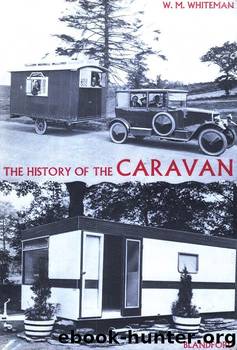The History of the Caravan by W.M. Whiteman

Author:W.M. Whiteman
Language: eng
Format: epub
ISBN: 9789085241522
Publisher: For the Benefit of Mr. Kite
Published: 1972-12-31T16:00:00+00:00
8
Road Performance
Touring caravans were less in the limelight than residential, though Eccles and other makers were doing very well with them. In speaking of touring caravans in the post-war years it is convenient to set a length limit of 17ft, for all caravans were more or less tourable. All were road vehicles governed by the trailer regulations.
In the 1945-46 revival shortage of materials severely controlled design. The 1946 Eccles Enterprise, with painted inside walls and furniture, was inferior to its 1939 equivalent in many things besides inside and outside finish. It stood higher off the ground, for cranked axles were scarce, and was clumsy and heavy. As supplies improved the makers were able to trim off nearly 5cwt. The changes that makers effected of their own choice were mostly retrogressive in relation to road performance. Shapes were less streamlined and, under the influence of wartime experience, width and headroom and so overall height were increased. Thus the centre of gravity was raised and aerodynamic drag aggravated.
Enforced austerity and the price war had other consequences. The cost of a lantern roof was forbidding, and even Burlingham for a time abandoned it. Wooden window frames, in 1939 found only on the cheapest vans, were once again common, and the windows tended to be small. The value of an end-to-end view through the van was forgotten except by a few veteran makers such as Winchester and Cheltenham. Around 1950 insulation was dropped in most of the cheaper vans. Partitions and toilet room doors were likely to end short of the ceiling. Although spring mattresses in high-class caravans continued to be eight inches thick, those in low-priced models were apt to be too hard or too soft, or the springs worked through the poor quality stuffing. Because of petrol rationing, towing was mainly transportation from A to B, and users were so pleased to be travelling at all that they were not disposed to be critical of roll, wag and snaking. The worn condition of a great many cars in any case put really good towing out of reach of the owners.
Weight saving received little attention. A length of 14ft was regarded as about the minimum for a family four-berth, and most vans in this class weighed well over a ton when loaded for a holiday. Touring with caravans of 25-35cwt was quite common. At the 1949 National Rally of the Caravan Club, whose members saw themselves as typifying the true mobile caravanner, there were a dozen 22-footers, and a 1952 Press report on the Eccles Adventurer, 18ft long with solid fuel stove, said ‘An ex works weight of 31¼cwt, with a nose weight of 1½cwt, makes it a comfortable touring model.’ The present sharp division between touring and residential was undreamed of. So was the present-day static holiday caravan. The only advances of value in touring were the more sophisticated brake expansion systems, Girling and Bendix, which during the war had become available for trailer hubs and were adopted by Coventry Steel, Car
Download
This site does not store any files on its server. We only index and link to content provided by other sites. Please contact the content providers to delete copyright contents if any and email us, we'll remove relevant links or contents immediately.
Aircraft Design of WWII: A Sketchbook by Lockheed Aircraft Corporation(31806)
The Great Music City by Andrea Baker(23043)
Call Me by Your Name by André Aciman(19064)
The Art of Boudoir Photography: How to Create Stunning Photographs of Women by Christa Meola(17894)
Shoot Sexy by Ryan Armbrust(17178)
The Secret History by Donna Tartt(16770)
Plagued by Fire by Paul Hendrickson(16671)
Portrait Mastery in Black & White: Learn the Signature Style of a Legendary Photographer by Tim Kelly(16522)
Adobe Camera Raw For Digital Photographers Only by Rob Sheppard(16427)
Photographically Speaking: A Deeper Look at Creating Stronger Images (Eva Spring's Library) by David duChemin(16188)
Bombshells: Glamour Girls of a Lifetime by Sullivan Steve(13160)
Pimp by Iceberg Slim(13002)
Ready Player One by Cline Ernest(12935)
The Goal (Off-Campus #4) by Elle Kennedy(12557)
Art Nude Photography Explained: How to Photograph and Understand Great Art Nude Images by Simon Walden(12393)
Kathy Andrews Collection by Kathy Andrews(10622)
Thirteen Reasons Why by Jay Asher(7860)
Goodbye, Things by Fumio Sasaki(7778)
Wonder by R.J. Palacio(7778)
